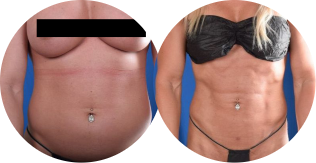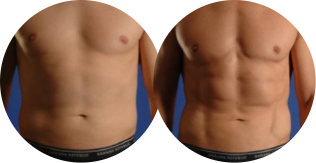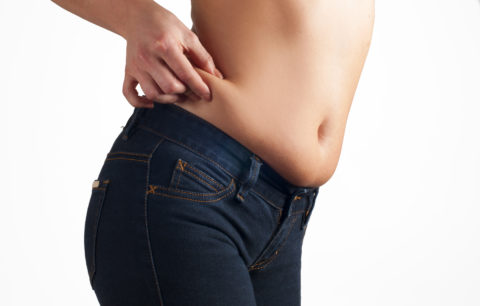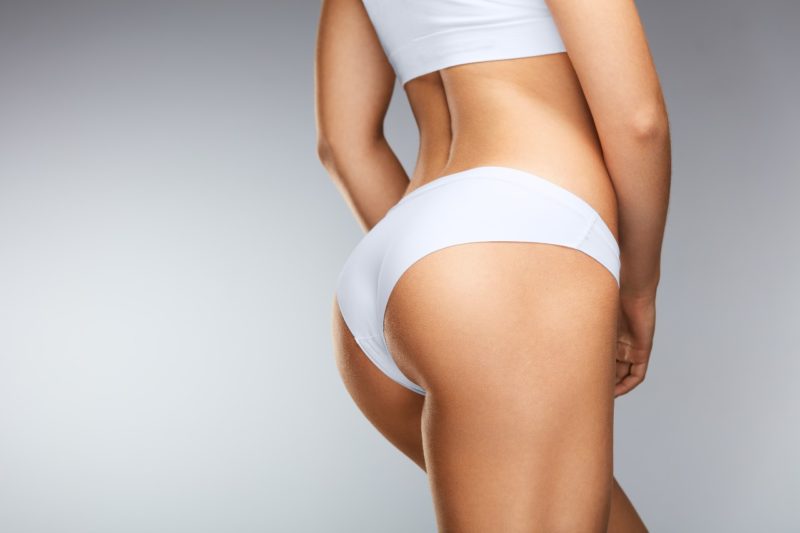Hips & Waist Liposuction
Offered at our convenient location in Denver
Hips and waist liposuction is a surgical solution to sculpt away unwanted fat tissue from the flanks, pubis, and hips. While all of our bodies store it differently, fatty tissue commonly collects in these areas, resulting in cumbersome, hard-to-lose deposits of fat that are firmly unresponsive to diet and exercise alone. Through trailblazing liposculpture techniques and technologies, Dr. John A. Millard can skillfully – and delicately – sculpt those stubborn reserves of fatty tissue from your silhouette, leaving behind a more flattering, chiseled outline to your appearance. If you would like to have Dr. Millard address fat around your hips and waist, please schedule a consultation at our Englewood location or give our office a call. Our number is (303) 792-5665.
Contents
Fat: The Good, The Bad, & The Subcutaneous
When discussing fatty tissue, it is important to understand the roles – both positive and negative – it plays in our body, and why some fat is impervious to diet and exercise alone. To achieve that understanding, we must understand exactly what fat does in the human body.
The Good
Adipose (fat) cells play a critical role in our body’s metabolism and physiology. These cells harbor energy in the form of triglycerides, a highly energetic molecule.[1] When activated, these fatty molecules release from their moorings and provide fuel for the rest of the body. In addition to this function, a healthy metabolism requires robust adipose tissue. Defects in adipose development do not lead to a healthy, lean person, but rather to lipodystrophy – a disease where other tissues like the liver take on the role of storing fat. This disease can lead to insulin resistance, diabetes, and other serious condition.[2] So, it is important to note that fat cells in and of themselves are not harmful but are vital to maintaining overall, balanced health.
The Bad
On the other side of the coin, too much fatty tissue, especially abdominal fat, can bring serious health concerns and complications. For almost 40 years, we have known the link between abdominal obesity and an increased risk of type 2 diabetes, cardiovascular disease, and death.[3] In one particular study, starting in 1986, nurses participated in the Nurse’s Health Study, one of the largest and longest studies that have measured abdominal obesity. It began with the over 44,000 U.S. nurses logging their hip-to-waist measurements. After 16 years, the women who had reported a 35 inch or higher waistline in their measurements were twice as likely to die of heart disease and numerous cancers than women with smaller waists.[4] The risks for cardiovascular disease steadily increased with each inch added around the waist.
The Subcutaneous
So, the science is clear that a balanced amount of fatty tissue around the body is necessary to sustain overall health and well-being. Commonly marketed by health gurus and fitness fanatics, diet and exercise routine are the staples to maintaining a healthy body and lifestyle. When done well, this dynamic duo has helped many people achieve their desired physique. However, for others, diet and exercise alone are no match for stubborn, unwanted fatty tissue around the waist and hips. That’s because this tissue is subcutaneous fat: fat that rests between the muscle and the dermis. It functions as an insulator to prevent heat loss, a barrier against dermal infection, and a protective cushion against physical, external stress.[5] Because the body employs this fat differently than other types of fat, the body only burns it once all other fat storage has been used. This is why certain areas of fat will remain even when the body is deprived of adequate nutrition.
Liposuction: A Subcutaneous Solution
When we’re young, our body responds differently to a healthy, balanced lifestyle: fat is easier to lose, muscle is easier to gain. But as we age, our metabolism pumps the brakes, and fat begins to solidify in new places. After perfecting your desired physique in the gym and the kitchen, you still may not see results, because your muscles are being masked by a cushion of subcutaneous fat. This is especially true for women who have just been pregnant. The adipose tissue that you have gained around your hips and waist during pregnancy might be too difficult to shed through diet and exercise alone.
That’s where liposuction enters the conversation. With liposuction, Dr. Millard can sculpt away this subdermal fat, leaving the skin to contour your hard-earned muscles directly. Through many advanced liposuction technologies and techniques, Dr. Millard chisels away fat from your hips and waistline, giving your silhouette a tighter, smoother profile. When focusing on the hips and waistline, Dr. Millard can address your:
Pubis
Fat between our belly button and groin is impossible to attack with core exercises because many workouts only focus on the upper and lower abdominal muscles. With liposuction, Dr. Millard can extract these enlarged fat cells and slim this small, yet vexing, area.
Love Handles
While “love handles” is a rather endearing name, their persistence in the face of diet and exercise can make them a thorn in your side – literally! While many workout regimens are marketed to shed love handles, these only target the oblique muscles: The swathes of muscle that border each side of the abdomen. Through liposuction, Dr. Millard can smooth out your love handles and restore the core of your physique.
Hips
More common in women than men, fat around the hips can make it incredibly hard to find pants, shorts, and dresses that fit well and make wearing them uncomfortable. It’s also an area of the body that’s extremely difficult to tone, and a common resting place for stubborn baby weight after pregnancy. However, with liposuction, Dr. Millard can erase these deposits of fat from your hips, making clothes more form-fitting and enjoyable.
Candidates
For those interested in liposuction for the hips and waist, we welcome you to schedule a consultation with Dr. Millard to see if you qualify. While it may change for individuals with unique surgical requirements, we generally recommend liposuction patients:
- Be at a healthy, stable weight before the procedure. Liposuction is not a weight loss surgery, rather, it is a body contouring treatment. Weight changes after your procedure can seriously affect the results of your liposuction procedure.
- Be a non-smoker or be able to quit smoking a few weeks before your procedure and the entire duration of your recovery. We ask this because nicotine is known to constrict blood vessels, hampering the body’s natural healing process.
Personal Consultation
Board-certified in plastic and cosmetic surgery, Dr. Millard is nationally and internationally known for his liposuction procedures. With his extensive backlog of knowledge and experience, he will be able to answer any questions you may have. First, Dr. Millard will determine whether you are a qualified candidate for liposuction. Next, he will decide on which liposculpture technique will best achieve your desired results. Finally, once he has outlined your treatment plan, he will ask that you discontinue smoking and any blood-thinning medications before your procedure. For pain management, one of our nurses will walk you through pharmaceutical options.
Recovery
Depending on your treatment plan, Dr. Millard will outline a recovery timeline. This timeline will include when you can return to your daily routine, work, and strenuous activities. We will give you a compression garment that you should wear around the treated areas day and night. It should only be taken off when showering. Be sure to attend all of your follow-up appointments and keep Dr. Millard and his staff up-to-date on your recovery.
Corresponding & Complementary Procedures
While liposuction around the hips and waist achieves many of our clients’ dream physiques, some may notice loose skin in the treated areas. This is because if the skin is stretched past a certain point it is impossible to bounce back. To accommodate those with loose, excess skin around their abdomen, Dr. Millard may recommend a tummy tuck. With a tummy tuck, Dr. Millard gently pulls the abdominal skin taut, contouring the underlying muscles. When paired with liposuction, a tummy tuck is perfect at erasing unwanted, loose skin from your midsection and unveiling a tighter, smoother abdomen.
Cost
The cost of your procedure will vary depending on what areas you have treated and the approach Dr. Millard utilized. During your consultation, Dr. Millard will be sure to address the cost of your personalized procedure as well as any additional services that may enhance your results. Please visit our financing page to learn more or give us a call at (303) 792-5665.
References
- Cohen, P., & Spiegelman, B. M. (2016). Cell biology of fat storage. Molecular biology of the cell, 27(16), 2523–2527. https://doi.org/10.1091/mbc.E15-10-0749
- Garg A. (2011). Clinical review#: Lipodystrophies: genetic and acquired body fat disorders. The Journal of clinical endocrinology and metabolism, 96(11), 3313–3325. https://doi.org/10.1210/jc.2011-1159
- Ohlson, L. O., Larsson, B., Svärdsudd, K., Welin, L., Eriksson, H., Wilhelmsen, L., Björntorp, P., & Tibblin, G. (1985). The influence of body fat distribution on the incidence of diabetes mellitus. 13.5 years of follow-up of the participants in the study of men born in 1913. Diabetes, 34(10), 1055–1058. https://doi.org/10.2337/diab.34.10.1055
- Zhang, C., Rexrode, K. M., van Dam, R. M., Li, T. Y., & Hu, F. B. (2008). Abdominal obesity and the risk of all-cause, cardiovascular, and cancer mortality: sixteen years of follow-up in US women. Circulation, 117(13), 1658–1667. https://doi.org/10.1161/CIRCULATIONAHA.107.739714
- Kwok, K., Lam, K. & Xu, A. Heterogeneity of white adipose tissue: molecular basis and clinical implications. Exp Mol Med 48, e215 (2016). https://doi.org/10.1038/emm.2016.5
